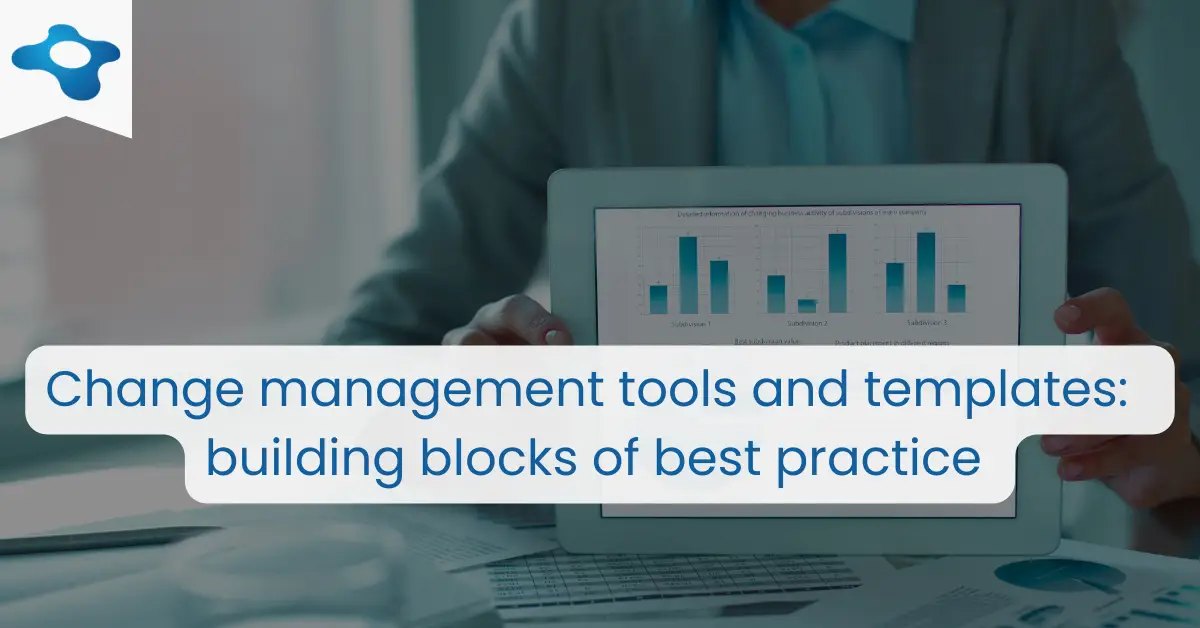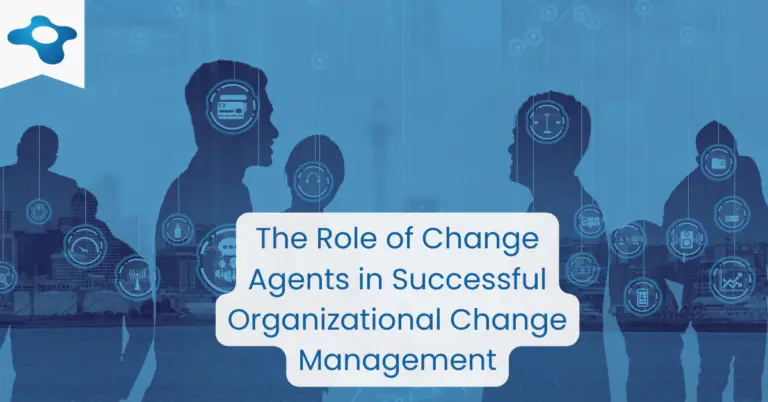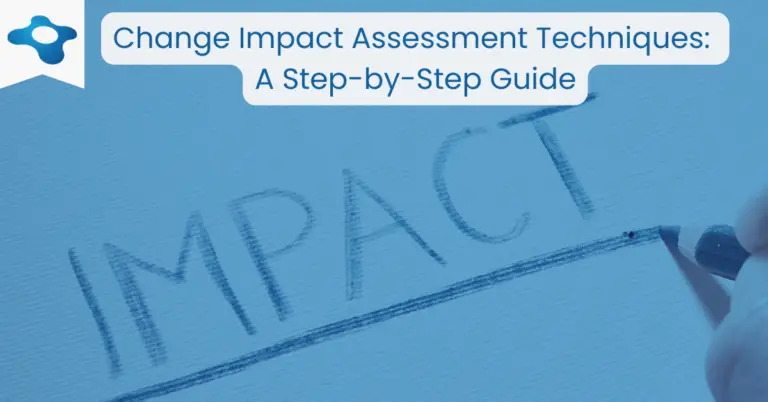Key Takeaways
- Change management tools and templates act as crucial building blocks for constructing project deliverables in accordance with best practices.
- Understanding the various categories of change management tools and templates will help you select the right resources for your specific change management program.
- Customizing these resources to fit your organization’s unique needs and project context is crucial for driving successful outcomes.
A successful change management initiative requires a range of tools and templates to help teams stay organized, communicate effectively and ensure that what they are doing aligns with the organization’s strategic goals.
A good set of change management tools and templates are the essential building blocks of higher-level change management processes, frameworks and methodologies.
They provide change practitioners with resources such as models, checklists and other useful documents that improve quality, save time and adherence to change management best practices.
In this article, we’ll explore a range of change management tools and templates including:
- various categories of change management tools and templates, including strategy, leadership, communication, performance, organization design, and measurement.
- how understanding these categories and their significance enables you to select the right tools and templates for your specific change management project.
- some of the most popular and widely-used change management tools and templates – offering valuable insights into the resources that have proven effective in diverse change management scenarios.
- how every organization is unique and the importance of customizing change management tools and templates to better align with your organization’s specific needs and challenges. Tailoring these resources to your context increases the likelihood of successful change projects.
- the choice between developing your own tools and templates internally or buying them in from an external source (spoiler: on most change projects you will utilize a mix of the two)
Categories of change management tools and templates
It will be useful to categorize change management tools and templates by the different aspects of a change initiative they seek to facilitate. These categories then provide a framework for selecting the right resources to support the needs of your change project.
Let’s now delve into the main categories of change management tools and templates, covering strategy, leadership, communication, performance, organization design and measurement:

1. Strategy
- Developing a clear strategy is the foundation of any successful change initiative. Change management strategy tools and templates facilitate the assessment, formulation and execution of a comprehensive change plan.
- These resources can include templates for SWOT analysis, vision and mission statement development and strategic roadmaps.
2. Leadership
- Effective leadership is vital for driving change and managing resistance. Leadership-focused tools and templates aim to strengthen the skills and capabilities of leaders within an organization.
- They can encompass resources such as stakeholder analysis templates, leadership style assessments, and coaching frameworks.
3. Communication
- Joined-up communication is crucial for gaining buy-in and moving stakeholders along the change commitment curve.
- Communication tools and templates help organizations create and execute communication plans, ensuring that key messages are delivered effectively. Examples include communication matrix templates, stakeholder mapping tools, and message frameworks.
4. Performance
- Monitoring the progress and success of a change initiative is essential for making data-driven decisions and ensuring that objectives are met.
- Performance-related tools and templates focus on tracking and measuring the impact of change, providing resources such as key performance indicator (KPI) templates, project dashboards and progress reports.
5. Organization Design
- Organizational tools and templates assist in managing the various aspects of change within a company, including its structure, processes, and culture.
- These resources can include organizational design templates, process mapping tools and cultural assessment frameworks.
6. Measurement
- Measuring the success of a change initiative is crucial for evaluating its effectiveness and identifying areas for improvement.
- Measurement tools and templates help organizations define and track success metrics, providing resources such as scorecards, surveys and evaluation frameworks.
Understanding these categories and their significance allows you to select the appropriate tools and templates for your specific change projects. With a comprehensive set of resources tailored to your organization’s needs, you can better navigate the complexities of change management and drive successful outcomes.
Popular change management tools and templates
There are numerous change management tools and templates available that can be applied to different aspects of change management initiatives.

Some of the most popular and widely-used tools and templates include:
1. Stakeholder Analysis and Mapping
- This tool is designed to identify and assess the various stakeholders who will be impacted by a change initiative, as well as to understand their level of influence and the most effective ways to communicate with them.
- A stakeholder map can help to visualize the relationships and dynamics among stakeholders, ensuring that their needs and concerns are addressed throughout the change process.
2. Change Impact Assessment
- This template helps organizations to evaluate the potential impacts of a change initiative on different aspects of the business, such as processes, systems, roles and culture.
- By understanding these impacts, organizations can develop targeted strategies to mitigate risks and address challenges associated with the change.
3. Communication Plan
- A key component of any change initiative, the communication plan outlines the messaging, channels, frequency, and timing of communications to different stakeholder groups.
- A well-crafted communication plan ensures that stakeholders are informed, engaged, and aligned with the change initiative.
4. Training and Knowledge Plan
- This template aids in the development of training and knowledge-sharing initiatives.
- Its purpose is to help employees acquire the necessary skills and knowledge to adapt to new processes, technologies, and ways of working introduced by the change.
5. Change Readiness Assessment
- This tool helps organizations to evaluate their preparedness for change by assessing factors such as organizational culture, leadership commitment, and employee readiness.
- The results of a change readiness assessment can inform the development of strategies to enhance change readiness and drive more successful outcomes.
The following tools and templates are sometimes overlooked but can be the difference-makers in a change initiative:
1. Future State Definition
- These visual representations of the desired end state help to create a shared understanding and inspire commitment to the change.
- Future state vision templates typically include elements such as strategic objectives, key performance indicators, and guiding principles.
2. Change Leadership Approach Indicator
- The Change Leadership Approach Indicator tool assists users in considering the three key factors of any change program.
- By providing a weighting for each factor, the tool suggests an approach to change leadership that best suits the change program circumstances.
3. Business Process Alignment
- This tool helps to identify and align the organization’s processes with the desired future state.
- Business process alignment templates typically include process maps, gap analyses and recommendations for improvements.
4. Culture Change Analysis
- By assessing the current organizational culture and identifying the desired future state, this tool enables organizations to plan and execute targeted culture change projects.
- Culture change analysis templates often include cultural assessments, gap analyses, and recommendations for culture change interventions.
5. Change Measurement Tool
- Measuring the success of a change initiative is vital for evaluating its effectiveness and identifying areas for improvement.
- Change measurement templates help organizations define and track success metrics, providing resources such as scorecards, surveys, and evaluation frameworks.
By incorporating these resources into your change projects, you can facilitate a more structured, transparent, and successful change process.
Customizing tools and templates for your change project
While these popular change management tools and templates provide a strong foundation for successful change projects, it is essential to remember that every organization – and change project – is unique.
Your tools and templates must be adapted and tailored to fit the specific needs, context and challenges of your organization to maximize its effectiveness.
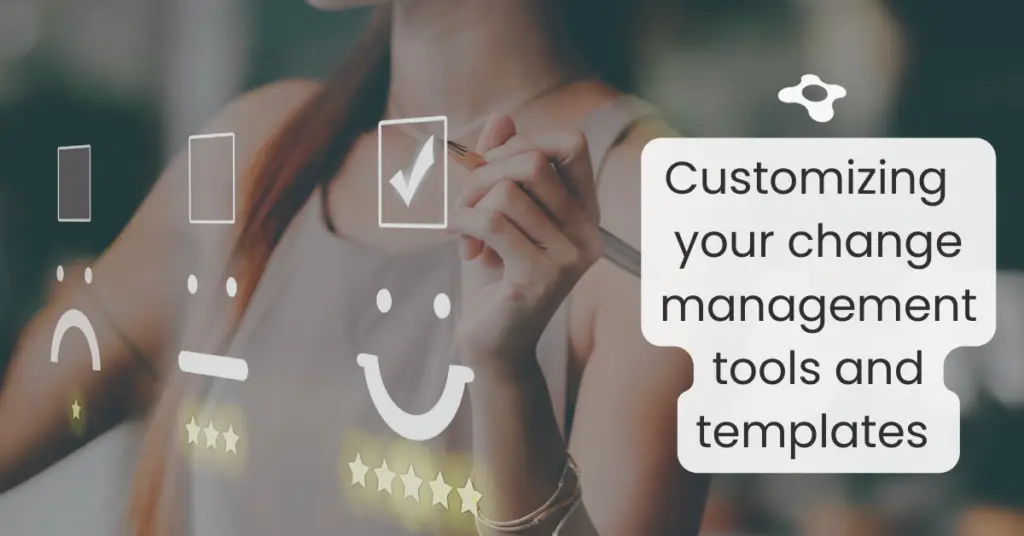
Here are some tips and best practices for customizing change management tools and templates to ensure alignment with your organization’s unique requirements and drive more successful change projects:
1. Understand the context of your change project
- To effectively customize any set of change management tools and templates, you must first develop a deep understanding of your organization’s context, including its culture, structure, processes and strategic objectives.
- It is this understanding that will inform your decisions about which elements of the tools and templates require modification and how they should be adapted to fit your organization’s unique circumstances.
2. Engage key stakeholders
- Involving key stakeholders in the customization process ensures that their perspectives, insights, and requirements are built into the tools and templates used across the change project.
- Engaging stakeholders early on also helps to secure their buy-in and support for the change initiative.
- Seek input from leaders, employees, and other relevant parties when adapting your tools and templates to your organization’s needs.
3. Align with your change management methodology
- Your organization may already have a preferred change management methodology in place, such as Kotter’s 8-Step Model, Prosci’s ADKAR framework or Changemethod’s change management methodology.
- Ensure that your customized tools and templates align with your chosen methodology, reinforcing its principles and supporting its implementation.
- If you opt for Changemethod, note that all the tools and templates are already fully aligned with the methodology, allowing for seamless integration and application.
4. Prioritize simplicity and suitability
- When customizing tools and templates, prioritize simplicity and usability to ensure that they can be easily understood and used by all relevant stakeholders.
- Complex or overly-detailed tools may discourage change practitioners from using the tools and templates – or even create confusion, undermining their original purpose of supporting change management initiatives.
5. Regularly review and update
- As your organization evolves and your change management initiatives progress, your customized tools and templates should be reviewed and updated as needed.
- Continuously refining and improving these resources ensures that they remain aligned with your organization’s changing needs and context.
By taking the time to customize change management tools and templates to fit your organization’s unique needs, you can maximize their effectiveness in supporting your change projects.
Tailoring these resources to your context not only enhances their relevance but also ensures that they resonate with your stakeholders and drive more successful outcomes.
Remember that customization is an ongoing process, requiring regular review and adjustment to maintain alignment with your organization’s evolving circumstances.
Changemethod: off-the-shelf, customisable tools and templates
Changemethod offers a comprehensive suite of over 100 diagnostic, planning, and execution tools and templates designed to support change management activities across a range of sizes and types of projects.
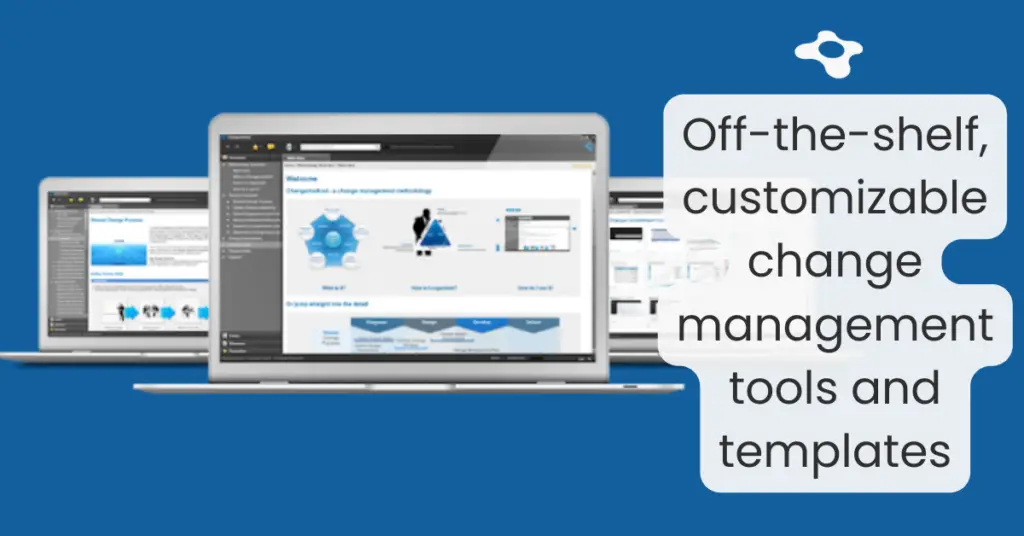
These resources are organized into six areas of best practice, which ensures a structured and holistic approach to change management. These areas of best practice are:
1. Shared Change Purpose
Focused on creating a compelling change management strategy that aligns with the vision of the future business environment and the implications for the organization’s future state.
Key tools and templates include:
2. Visible Change Leadership
Aimed at helping executives effectively lead change at various levels within an organization.
Key tools and templates include:
3. Smart Engagement and Communication
Ensures that stakeholders are informed and engaged throughout the change process.
Key tools and templates include:
4. Strong Individual Purpose
Focuses on helping individual employees adopt and ‘own’ new processes, technologies, and ways of working.
Key tools and templates include:
5. Supportive Organization and Culture
Addresses the implications of change programs on an organization’s structure and aligns the organization with future business processes.
Key tools and templates include:
6. Meaningful Change Measurement
Helps track change progress and ensures that the value described in the business case for change is realized.
Key tools and templates include:
Changemethod’s tools and templates are fully aligned with its 21 change management process guides and six areas of best practice. By utilizing these resources, organizations can optimize their change management efforts and drive successful outcomes.
FAQ on change management tools and templates
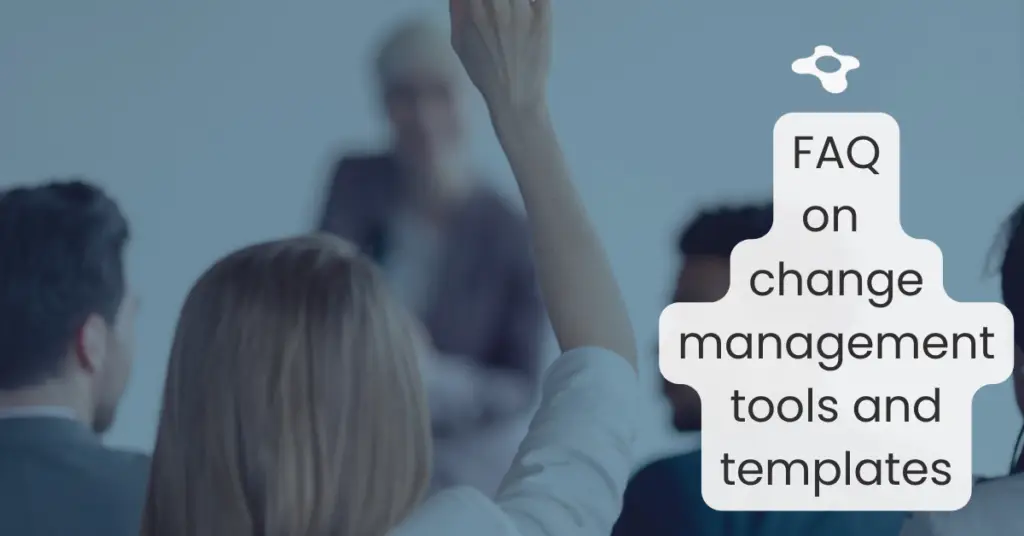
What is the difference between change management tools and templates?
Tools are practical resources, such as checklists, frameworks, and models, that help change practitioners execute specific tasks within the change management process.
Templates, on the other hand, are pre-formatted documents that guide practitioners in creating standardized deliverables, such as plans, reports, and assessments
Do I need to use all the tools and templates mentioned in this article for my change initiative?
Not necessarily.
The tools and templates you choose to use should be based on your organization’s specific needs and change management objectives. It’s important to assess your organization’s unique context and select the most appropriate resources to support your change projects.
How do I know if a particular change management tool or template is right for my organization?
Consider your organization’s context, objectives and existing change management processes. Assess whether a given tool or template aligns with your organization’s needs, culture, and strategic goals.
You may need to customize the tool or template to better fit your organization’s unique circumstances.
Can I combine different change management methodologies when using tools and templates?
Yes, absolutely.
Many organizations find value in combining elements of various change management methodologies to create a customized approach that suits their unique needs.
When doing so, ensure that the tools and templates you use are aligned with your chosen methodologies and support your overall change management strategy.
How often should I update and review my change management tools and templates?
It’s important to regularly review and update your tools and templates to ensure they remain aligned with your organization’s evolving needs and context.
This may involve making adjustments as your organization grows, adapts to new challenges, or adopts new strategic objectives.

